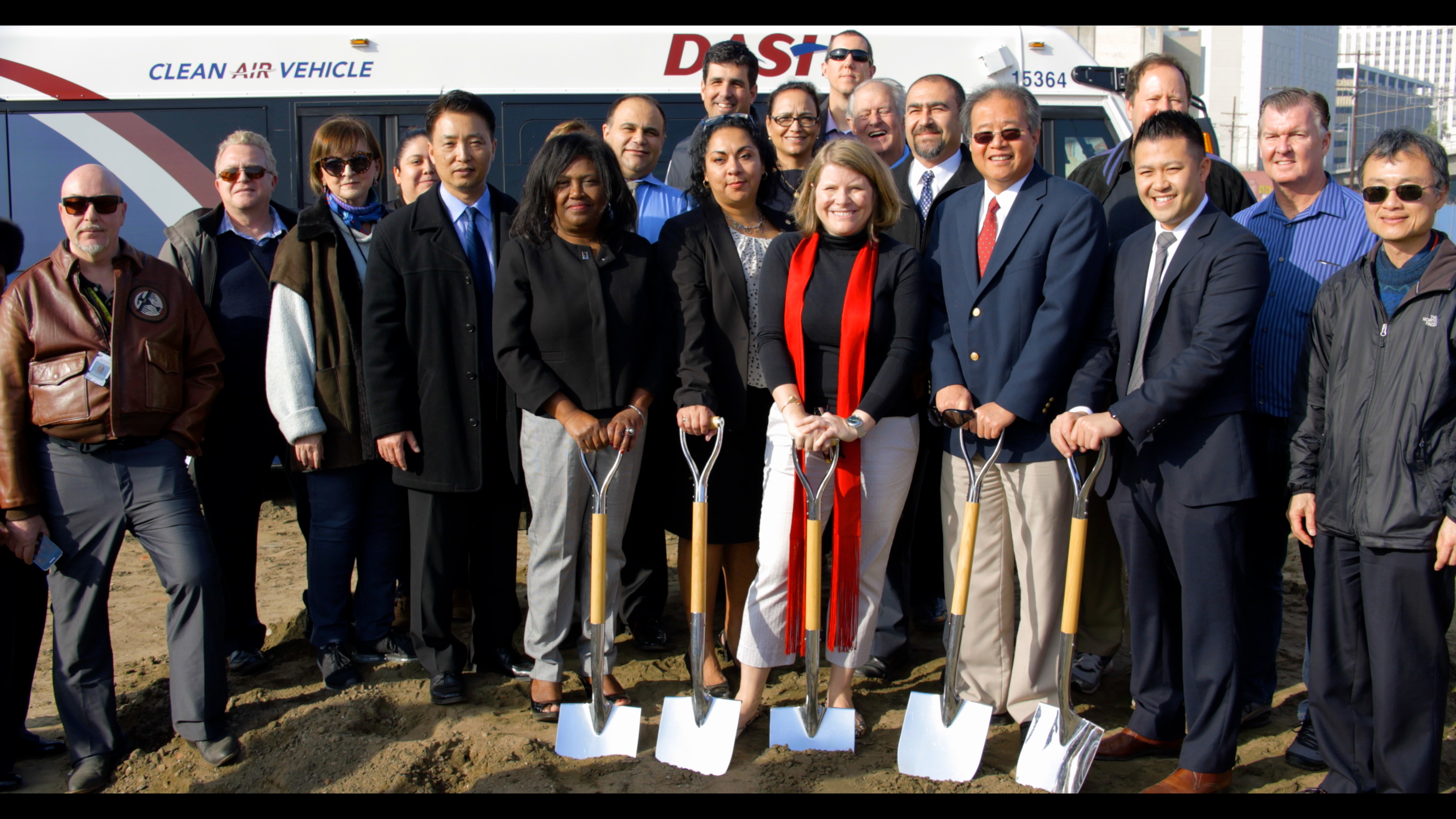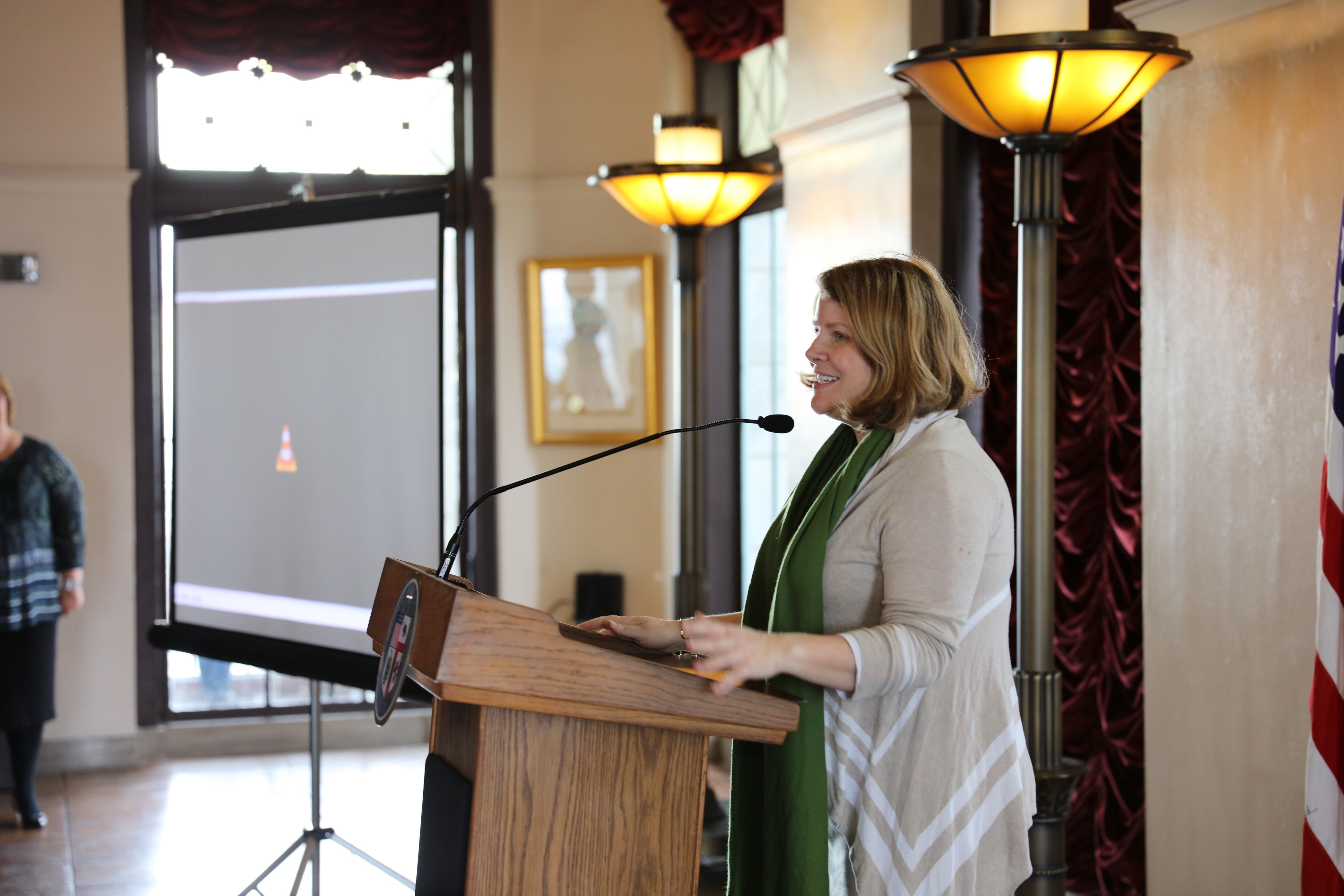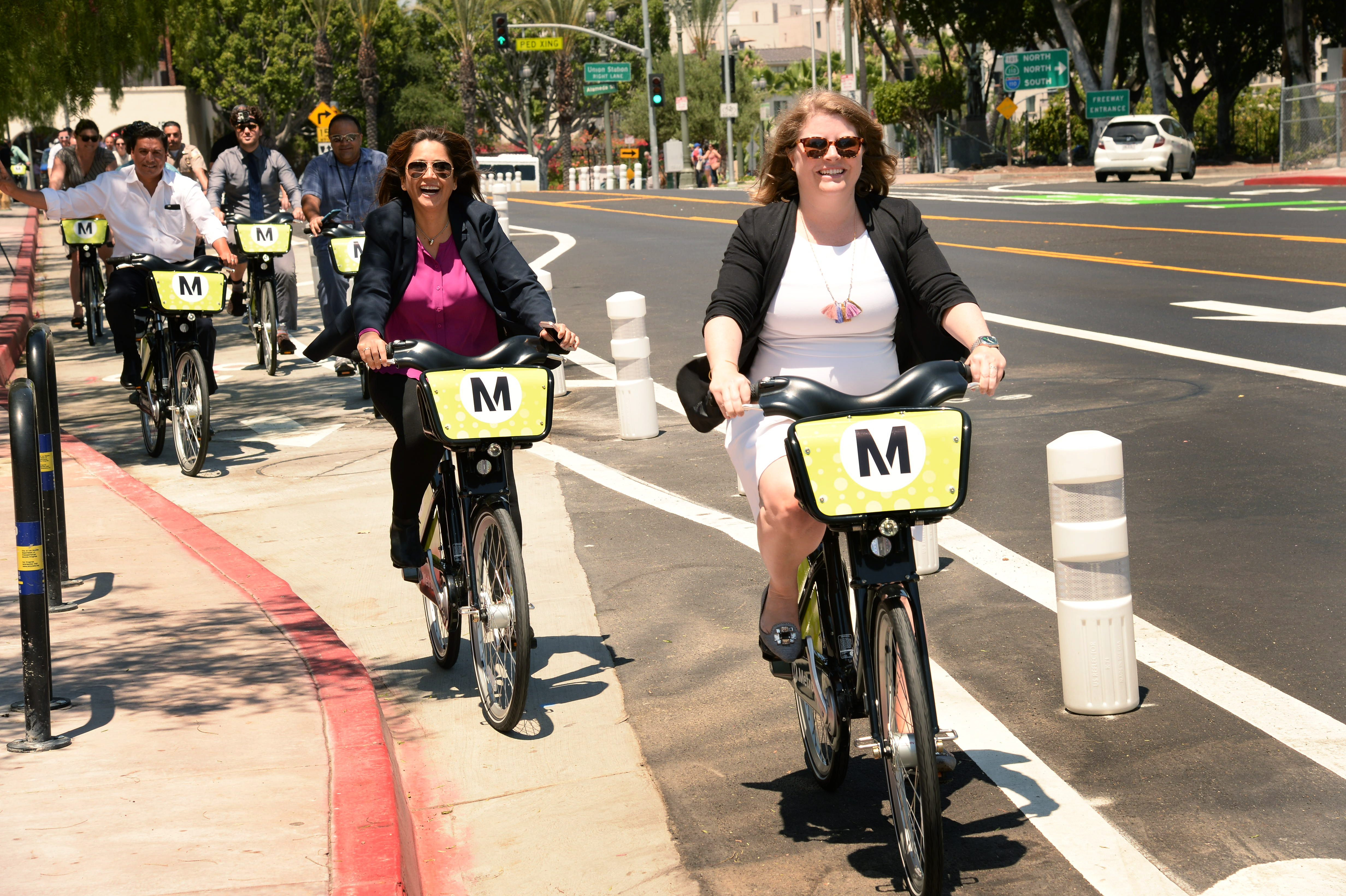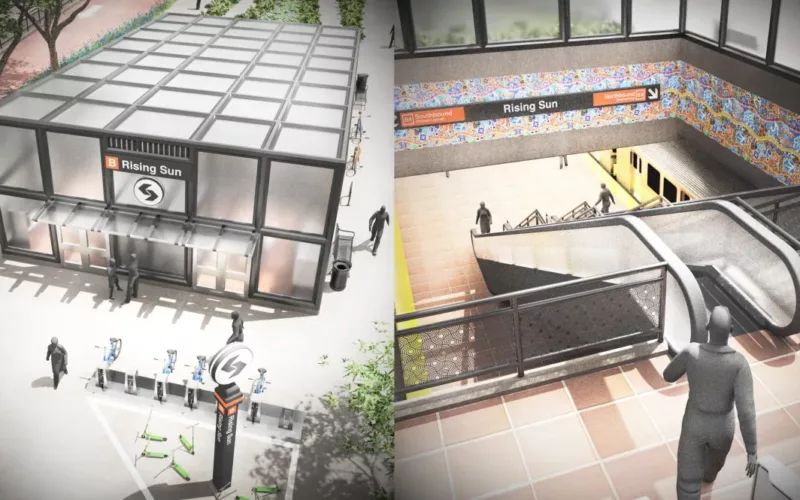
Seleta Reynolds was appointed General Manager of the Los Angeles Department of Transportation by Mayor Eric Garcetti in 2014. She is responsible for implementing Great Streets for Los Angeles, a plan to reduce traffic fatalities, double the number of people riding bikes, and expand access to integrated transportation choices for Angelinos and the region. Previously, she was a leader in the San Francisco Municipal Transportation Agency’s Livable Streets division. TransitCenter interviewed Seleta for our latest publication, “All Transportation is Local: A Field Guide for City Leaders.”
TransitCenter: In All Transportation is Local, we argue that it’s essential for city departments and transit to work together, and there’s often an attitude in places that transit is someone else’s problem. How do you think about it and how does the department contribute to the progress of transit?
Reynolds: The interesting thing about LA DOT is that we do operate a transit system. We’ve got DASH and Commuter Express, and it’s a fleet of about 350 vehicles, and we do about 26 million trips every year. Even though that’s a pretty substantive system, it pales in comparison to [Los Angeles] Metro. So, we are operating this entrepreneurial little start-up transit system, in the same ecosystem as this very large, well-established, multi-layer transit system.
I see the success of traditional surface transit as actually a DOT function. If Metro wants to do a bus rapid transit line down Wilshire Boulevard, arguably that’s a city project. There are tremendous benefits to the overall operations of the street when you can dedicate a couple of lanes to really efficient high-capacity transit. But that requires the city to go in and make the [traffic] lights prioritize transit, to redesign the street so that there are transit-only lanes, to make decisions about whether the route is center-running or side-running, and where the platforms are going to be.
We need to make sure we’re working closely with Metro to make sure they’re doing things like all-door boarding, and having ticket vending machines where people can purchase their tickets on the platform rather than on the bus. There has to be a really strong synergy, but then there’s such tremendous benefit.
In the end, these are all the same people. My customers, who live in the city of Los Angeles – it’s not like they stop being City of LA residents when they get on a Metro bus. I care about their whole trip and their whole experience, whether it’s on LA DOT transit or on a Metro bus.
TransitCenter: In terms of DOT operations, how do you take an organization that’s used to doing things by the book, and make it comfortable with taking new risks?
Seleta Reynolds: There are things that I would describe as changing the philosophical approach, and then some structural things that you need to do simultaneously.
At the philosophical level, the first thing any new leader needs to do when coming into an organization is ask thoughtful questions and listen. Really try and understand what the culture of the organization is, and what people in the organization value in that culture. That’s your jumping-off point for figuring out how much pivoting you need to do to get the culture to a place where people are comfortable taking risks.
I’ve spent most of my career in an engineering culture, which has as one of its bedrocks an aversion to risk, because there’s no reward for risk-taking. You’ve got people who are trying to adhere to a really high standard, working in the public right-of-way, which has a visceral impact on people’s day-to-day safety and quality of life. In that forum, you do need to balance risk and figure out a framework for risk-taking.
So first you have to create a culture that rewards thoughtful risk-taking. A critical piece of that is being willing to stand up and take the blame when the risks don’t have the kind of result that you were hoping for, and making sure that your staff know you have their back. The second piece is creating a culture of feedback and accountability that holds people accountable for not taking thoughtful risks.
Then, from a technical perspective, it’s about making sure that forums exist where the culture can have a transparent discussion about new or innovative ideas and understand the design and operational decision-making context.
So, when I got to LA DOT for example: There were strong, respected thought leaders who had been at LA DOT for a long time, and if you had a new idea and you had a good relationship with one of them, then you could probably get your idea due consideration. But if you were new to the organization—or maybe you had a bright idea for how to time signals better for the buses, but you weren’t in the signals planning group—then your idea was not likely to get a lot of play. So ideas were sort of succeeding and failing on the basis of people’s individual relationships.
To change that, I created a Complete Streets Committee where all of those thought leaders come together on a monthly basis, there’s an agenda, and anybody in the department can bring their ideas to that group and have them vetted and refined to bring them to life.
Doing an autopsy on how the department makes its decisions, and then making structural changes in response is important to make sure new ideas get their day in court.
 TransitCenter: What is success for your department and how do you measure it?
TransitCenter: What is success for your department and how do you measure it?
Reynolds: There are three overarching goals that the department has, and we have our strategic plan which lays out specific benchmarks and milestones that we’re expected to meet over three years.
The first bucket of how we’re measuring success is around building safe, beautiful streets. The key initiative there is Vision Zero, a goal to get to zero traffic deaths by 2025. It’s very data-driven; we’ve gone through an exercise where we mapped out all the severe crashes involving people walking and biking in the city, because they account for about half of the overall deaths that we see in the street every year. Then we are focused to getting to a 20% reduction in fatalities in 2017 – we’ve gone through and identified which corridors we really need to focus on and just came out with our action plan for Vision Zero.
Our second bucket is giving people mobility choices for how they get around the city. We put together a transportation technology strategy that has very specific actions to broaden the field of choices that people have and to bring the experience of all of those non-single-occupancy trips—whether it’s transit or car sharing or bike sharing—up to the same level of ease at which people get into their personal vehicles now. We have an emphasis on things like user experience, and ease of payment, and travel time reliability for all of those choices. But the overarching goal is to get to a 50/50 split between all of those other ways of getting around versus driving personal vehicles.

Then, the last bucket is about making LA DOT a great place to work. That’s probably where I spend most of my time, and it’s the toughest part of the job. I’m the eighth general manager in the last 14 years. I have to rebuild trust and improve engagement with the 2,000 people who work for LA DOT. That’s not something I’m going to deliver overnight; it’s requires that I show up the same way over and over and over again so that I build credibility for the people who are working for me.
We’ve instituted an annual employee survey which measures employee engagement and which I use to guide the investments we make in the department itself – professional development, performance measurement, evaluations, mentoring, and succession planning. I want staff to see over and over again that I’m listening and following their lead.
Another pillar is employee recognition. During the economic downturn, the city eliminated its service pin ceremony. If you had been at the department 10, 20, or 30 years, you’d get a service pin that recognizes your service, and if you had more than 30, you get recognized in front of the Transportation Commission, and they just stopped doing that.
I’ve never worked in a city where service pins are not elevated to a really high level by employees. They see it as the city’s commitment to recognizing and appreciating its professional class. It may seem like a small symbolic thing, but it had deep cultural impact when they eliminated the pins.
So we brought service pins back, and I took down all the pictures of the executive team in the main lobby of the DOT building and replaced them with pictures of employees that we recognize as part of a employee recognition program every month.
We brought back things like ice-cream socials and holiday parties, and going out and visiting all of our satellite offices. Every member of the executive team is responsible for taking some donuts out to every single facility to make sure the line staff sees someone from executive leadership at least once every year. We have a big breakfast that celebrates our star performers once a year. These are all simple things. I didn’t need anyone’s permission to do these and they’re not very expensive. It just took someone to say, we’re going to make it a priority.
The last pillar is probably the hardest one, and that is trying to change DOT into more of a meritocracy. That includes fundamental changes to our hiring process. Instead of just asking questions about your technical skills or having a process that’s a check-the-box exercise because people have “waited their turn,” we are making the interview process very rigorous. We do that by having a written exercise as part of it, having a presentation or simulation as part of it—so we actually have candidates pick up the phone and deal with an irate resident, and see how they perform under pressure. We are making more of the questions in these interviews emotional intelligence questions, not technical skills questions.
The other piece of it is holding people accountable for poor performance. That’s been really tough. But I think it’s probably one of the most important pieces of the entire program, because it’s what you do for your good people in a civil service environment.
I can’t give people raises; I can’t give them promotions; I can’t give them bonuses; I can’t give them extra vacation days. There are a lot of tools that are in the private-sector management toolbox that don’t exist in the public sector. So, one of the things that you do for your good performers is to hold your poor performers accountable.
If you have someone who comes in everyday and gives 115%, and they sit right next to somebody that goofs around and isn’t productive, it’s contagious. If you don’t deal with low performance, then it spreads to your high performers. Because they think, “I’m getting paid the same amount; I’m the same classification as this person. What is the point?” So, that piece of it is pretty undervalued, but really important.
 On the Brink: Will WMATA’s Progress Be Erased by 2024?
On the Brink: Will WMATA’s Progress Be Erased by 2024?
The experience of being a WMATA rider has substantially improved over the last 18 months, thanks to changes the agency has made like adding off-peak service and simplifying fares. Things are about to get even better with the launch of all-door boarding later this fall, overnight bus service on some lines starting in December, and an ambitious plan to redesign the Metrobus network. But all of this could go away by July 1, 2024.
Read More To Achieve Justice and Climate Outcomes, Fund These Transit Capital Projects
To Achieve Justice and Climate Outcomes, Fund These Transit Capital Projects
Transit advocates, organizers, and riders are calling on local and state agencies along with the USDOT to advance projects designed to improve the mobility of Black and Brown individuals at a time when there is unprecedented funding and an equitable framework to transform transportation infrastructure, support the climate, and right historic injustices.
Read More